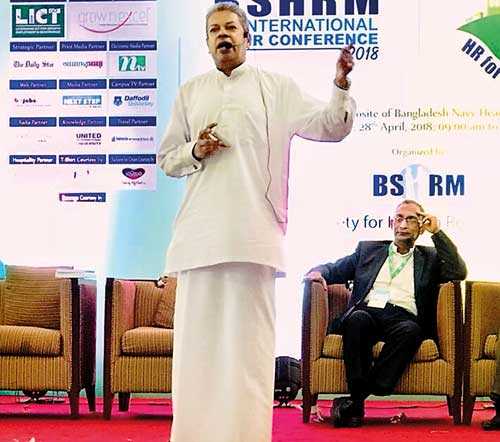Monday Dec 22, 2025
Monday Dec 22, 2025
Tuesday, 8 May 2018 00:00 - - {{hitsCtrl.values.hits}}
We in Sri Lanka observe ‘International Labour Day’ on 7th May instead of 1st May, this year. From Haymarket Square, Chicago in 1886, it has come a long way in bringing workers’ rights to the forefront. It is an opportune time to reflect on national policies and local practices related to labour with emphasis on employment.
Overview
I was addressing an International HR Conference in Dhaka, Bangladesh, as a keynote speaker on “people factor for sustained results”. With the enthusiastic questions and answers session that followed, it was not difficult to identify the key challenges in driving a dynamic labour force. It has a key policy dimension and also a practical dimension. It prompted me to recall the ‘National Human Resources and Employment Policy (NHREP)’ launched in Sri Lanka several years go. Despite its dormant status today, the salient points that were captured in it are still solid and valid.
The NHREP sets out the overarching policy framework to provide full, decent and productive employment to all Sri Lankans. It is the foundation on which human resource capabilities would be strengthened and employment opportunities created to make Sri Lanka to reach its aspirations.
The NHREP has stated its vision as:
‘Sri Lanka, the Wonder of Asia, in which all persons of working age become globally competitive and multi-skilled, and enjoy full, decent and productive employment with higher incomes in conditions of freedom, equity, security and human dignity.’
It clearly shows the alignment to the national priorities and emphasis on the employee aspects. Based on labour statistics, the policy report states that those of the workforce having higher educational achievements are overrepresented among the unemployed, suggesting that there is a shortfall in demand for educated workers. Further, low rates of labour force participation and high level of unemployment among women, as well as the gender disparity in wages, shows that women are at a distinct disadvantage in the labour market.
As the policy report further states, Sri Lanka is moving from a factor-driven economy towards an efficiency-driven economy, leading on to an innovation-driven economy. The human resource plans will explore possibilities to leapfrog towards an innovation-driven stage. The performance of human resources-related factors is critical and related to global competitiveness. These factors will be examined constantly and measures taken for appropriate adjustments, so that the economy will move smoothly towards this innovation-driven growth stage.
Key Aims of NHREP
The main objectives of the NHREP have been identified as follows:
1.To promote the attainment of full, productive and freely chosen employment for all women and men in Sri Lanka
2.To develop a highly competent, globally competitive, multi-skilled and productive workforce
3.To improve incomes and the quality of life of the working population across different sectors and regions
4.To provide the fullest possible opportunity to each worker without discrimination, to qualify for and to use his/her skills and endowments in a job for which he/she is best suited, so that worker motivation and productivity are maximised
5.To safeguard the basic rights and interests of workers in line with national labour laws and key international labour standards
The above seems to be timely and relevant with challenges of implementation. They are also comprehensive in nature and collaborative in application. As the report further illustrates, a national human resources and employment policy is needed to guide the use of the country’s labour-force effectively for the overall development of the country. In achieving rapid development as aspired, Sri Lanka needs to prevent the skills of the work force from becoming a constraint on development.
Key Contents
The policy report contains key policy components pertaining to several key areas: human resources planning; development and productivity; school education; higher education ; vocational skills and employability; career guidance and counseling; enhancing employability of the youth; science, technology and innovation skills; sectoral policies; informal employment; small and medium enterprises (SME); employment opportunities for vulnerable groups, disabled persons and those in underdeveloped regions; foreign employment; public service employment; mainstreaming gender; labour market information and employment services; social dialogue institutions and labour relations; wages and social protection.
Sectorial policies include sectors such as agricultural, manufacturing, tourism, ICT & BPO, health services and ports & shipping. It also speaks of environment friendly (green) jobs, infrastructure investments, performing arts, music and creative industries as well as other emerging spheres.
HR Planning, Development and Productivity
In perusing through the policy document, I found the section on HR planning, development and productivity particularly interesting from an HR professional’s point of view. As the report states, the importance of planning and development of human resources in a country’s development process cannot be over-emphasised. Effective human resource planning implies that sufficient human resources, with the right mixture of talent, are available in appropriate locations, performing their jobs according to their skills and aspiration.
At present, Sri Lanka lacks comprehensive information in regard to human resource requirements. It is on the basis of reasonably accurate projections about how many skilled workers of different categories the country requires to meet current and emerging needs that arrangements could be made to supply the high quality human resource requirements. All relevant authorities in the public sector could undertake studies of human resource requirements in all key categories during the NHREP period. It goes without saying that systems have to be devised to do the same for the private sector as well.
The NHREP report further states that the demographic profile of the population and the labour force, and their expected changes over time, are taken into account in human resource planning and development. Particular emphasis is placed on required policy responses to changing proportions of the young and the old in the population, the extent of women’s labour force participation, and overseas migration for work. While action is planned to address skills inadequacies caused by overseas migration of skilled workers, policies will be designed to continuously improve labour productivity at both macro and sectoral levels.
Low labour productivity is often highlighted as a major factor behind the high cost of production and low profits. This hampers local private investment, as well as foreign direct investment, and thereby restricts employment opportunities. Low productivity leads to loss of market competitiveness and slow industrial progress. A set of productivity standards needs to be developed and established at enterprise level, ensuring that employees also would gain from productivity growth. Labour productivity indexing and standardisation in respect of different industries and economic sectors are to be developed. Medium and long-term labour productivity targets will have to be declared at macro, sector and subsector levels based on corresponding projections.
The fact that the skill requirements in the labour market are constantly rising as a result of globalisation and technological change is noted. Talents of young people, and the need to provide opportunities for them to develop those talents, are recognised. More effective and more competent workers will help enterprises to remain competitive in global and regional markets.
The report summarises the following are some key issues/ problems affecting human resource planning and development:
nMismatch between the education and training provided to people and resultant expectations of the youth, on the one hand, and the skills and knowledge demanded in the current and emerging world of work on the other.
nInadequate mechanisms to address skills development and employment issues pertaining to the large numbers dropping out annually from the formal education system.
nAbsence of mechanisms to encourage labour productivity and also a productivity-oriented working culture.
nHigh wage and other costs of labour, particularly in respect of higher and more skilled positions, having a direct impact on employers’ decision to hire and to re-train staff. Re-training becomes particularly costly in the context of high turnover of skilled labour.
nLack of a business-friendly environment (e.g., legal, infrastructure, etc.) to facilitate investments in new enterprises.
There is no doubt that the above issues should be addressed in a collaborative manner, and coordination between key public sector organisations, as well as key private enterprises, should be vital in such an endeavour. Whether we are aware of such a need, and whether we are willing to commit to fulfill such a need, is the question.
Challenges ahead
“The one who adapts his policy to the times prospers, and likewise that the one whose policy clashes with the demands of the times does not,” said Niccolo Machiavelli. Whilst the contents of the NHREP are still valid, resurrecting it with a renewed interest is a key challenge.
The sad practice of ‘throwing the baby away with the bathwater’, widely prevalent in local political circles, has badly affected the process of implementing NHREP. The National Human Resource Development Council (NHRDC) can play a pivotal role in updating it or upgrading it if necessary, rather than uprooting it. A starting point could be a discussion among HR professionals about the information contained in it and implications of their implementation. Professional bodies such as the Institute of Personnel Management (IPM) and the Association of HR Professionals (AHRP) can play a pivotal role here.
Moving beyond just celebrating Labour Day, paying serious attention to the implementation of NHREP could be a vital step towards right direction. With political wish and professional will, it can be made a vibrant reality for the betterment of the masses.
Prof. Ajantha S. Dharmasiri can be reached through [email protected] , [email protected], [email protected] or www.ajanthadharmasiri.info